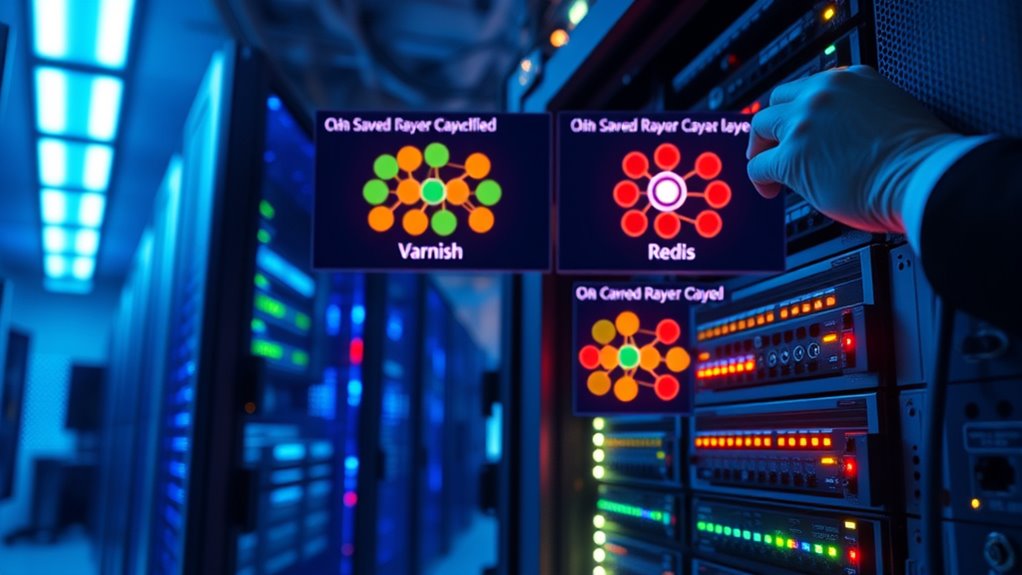To configure server-side caching with Varnish, Memcached, and Redis, start by setting up Varnish as a reverse proxy and customize its behavior using VCL files to enhance caching policies. Install and tune Memcached for fast key-value storage, adjusting parameters like memory size and connections. Use Redis to leverage its versatile data structures for more complex caching needs, such as sessions or real-time data. Combining these tools effectively boosts website speed and scalability—exploring further helps you master their ideal configurations.
Key Takeaways
- Configure Varnish with VCL scripts to define caching policies, TTLs, and request filtering for optimal HTTP content caching.
- Set up Memcached with appropriate parameters (-m, -l, -U, -c) and install client libraries for seamless integration with applications.
- Utilize Redis data structures (strings, hashes, sets) to cache diverse data types, enabling flexible and efficient server-side caching.
- Implement cache invalidation strategies such as TTL expiration, event-driven updates, and validation headers to maintain data freshness.
- Monitor cache performance metrics and fine-tune configurations to improve responsiveness, reduce load, and prevent stale content.
Understanding the Role of Varnish in Web Caching

Varnish plays a crucial role in web caching by acting as an intermediary between your users and the origin server. It’s an open-source HTTP reverse proxy designed to speed up web applications by caching frequently requested content. When a user makes a request, Varnish checks its in-memory cache first. If the content is there, it serves it directly, reducing load on the origin server and cutting response times. If not, Varnish forwards the request to the backend server, retrieves the response, caches it, and then delivers it to the user. Unlike browser caching, Varnish caches at the server level, benefiting all users. Its architecture is highly threaded, enabling it to handle many connections simultaneously, maximizing throughput and efficiency. This setup greatly enhances website performance and scalability. Additionally, understanding cybersecurity vulnerabilities associated with caching systems is essential to prevent potential exploits, especially considering the importance of cache invalidation to maintain data consistency.
Configuring Varnish With VCL for Optimal Performance

Configuring Varnish with VCL allows you to tailor caching behavior to meet your application’s specific needs. You can control how requests are handled at different stages using core subroutines like `vcl_recv` and `vcl_backend_response`. In `vcl_recv`, you optimize cache efficiency by removing unnecessary cookies, blocking unwanted user agents, or redirecting requests. You can also implement request filtering to further streamline cacheability and reduce backend load. Properly managing cacheability ensures that static content is served efficiently while dynamic content remains fresh. In `vcl_backend_response`, you set TTL values to balance freshness and performance, override cache-control headers, and implement grace periods for serving stale content during backend delays. You can also enable grace and saint modes to enhance resilience, serving stale content during outages or backend saturation. Additionally, understanding cache-control headers helps you fine-tune content freshness and browser behavior for optimal results. Incorporating health checks into your VCL configuration can help monitor backend status and improve cache reliability during failures.
Setting Up Memcached for Quick Data Retrieval

Setting up Memcached for quick data retrieval involves installing the service and configuring it to suit your workload. You can install Memcached via OS package managers like `apt` or `yum`, or build from source for newer features. Remember, the default installation doesn’t cache data automatically; your applications need to implement Memcached clients. For PHP, install the `php5-memcached` extension to guarantee compatibility with PHP 7 and above. When configuring, set the `-m` option to allocate at least 1024 MB of RAM and use `-l` to specify the listening IP, typically `127.0.0.1`. Adjust the `-U` flag to disable UDP for security, and `-c` to set maximum connections, ensuring your cache can handle high traffic. Use system commands to start, stop, and enable Memcached at boot, and monitor logs for performance tuning. Additionally, understanding caching mechanisms can help optimize your setup for better efficiency. Moreover, configuring your cache properly can help prevent infections or issues related to improper setup or vulnerabilities. Regularly reviewing performance metrics can further improve your cache’s responsiveness and stability. To improve security, consider setting up access controls and regularly updating your Memcached installation to patch known vulnerabilities.
Leveraging Redis Data Structures for Advanced Caching

Redis offers a variety of data structures that enable you to implement more sophisticated and efficient caching strategies. Strings are ideal for simple, TTL-enabled caching of HTML pages, API responses, or sessions, with commands like `SET key value EX seconds` ensuring atomic expiration. Hashes store multiple field-value pairs under a single key, perfect for caching structured data such as user profiles, reducing network overhead and simplifying updates. Lists and sets support queue-like and tag-based caching, allowing fast insertion, deletion, and membership testing—crucial for activity logs or permission sets. Sorted sets rank items by scores, making them suitable for leaderboards, time-series data, or prioritized caches. Understanding data structures in Redis is essential for designing effective caching solutions that meet your application’s specific needs. Additionally, choosing the appropriate data structure can significantly impact the performance and scalability of your caching system. For example, leveraging data organization techniques can help you tailor your cache design to optimize access patterns and resource utilization. A solid grasp of cache management principles can further enhance your ability to maintain efficient and reliable cache layers.
Comparing Performance and Scalability of Varnish, Memcached, and Redis

When choosing a caching solution for your web infrastructure, understanding how Varnish, Memcached, and Redis compare in performance and scalability helps you make informed decisions. Varnish excels at HTTP request caching, reducing backend load with minimal latency, especially when cache hit rates are high. Memcached and Redis offer sub-millisecond response times for in-memory key-value storage, suitable for high-traffic applications. Memcached’s multi-threaded design handles large datasets efficiently, while Redis’s clustering supports scaling but adds complexity. Redis uses less memory per record and supports complex data structures, enhancing flexibility. Varnish scales horizontally with multiple instances, whereas Redis and Memcached scale through clustering or sharding. Your choice depends on your specific workload, cache type, and scalability needs. Additionally, understanding the integration capabilities of each system with your existing infrastructure can significantly impact overall performance and manageability. It is also important to consider the expiration of cached data, especially in environments where data freshness is critical. Moreover, being aware of the common financial terms and jargon related to your infrastructure investments can help you better evaluate the costs and benefits of each caching solution. Lastly, assessing the development and maintenance requirements of each option ensures sustainable long-term performance.
Strategies for Cache Invalidation and Data Consistency

Effective cache invalidation and maintaining data consistency are crucial for ensuring your cached content remains accurate and reliable. You can use various strategies to achieve this, such as time-based approaches like TTL and max-age headers, which automatically expire cached data after set periods. Event-driven methods, including content updates and real-time invalidation, refresh the cache based on specific triggers. Cache replacement policies like LRU and LFU help manage limited space by removing stale entries. Header-based validation with ETag and conditional headers ensures efficient revalidation without unnecessary data transfers. Additionally, implementing cache coherence mechanisms can prevent stale data issues across distributed systems. Here’s a quick overview:
| Strategy | Method | Purpose |
|---|---|---|
| TTL-Based Invalidation | Set expiration times | Auto-expire outdated cache |
| Event-Driven Invalidation | Content updates, triggers | Keep cache fresh with events |
| Header-Based Validation | ETag, conditional requests | Validate cache with server |
| Replacement Policies | LRU, LFU | Manage cache size and relevance |
| Data Consistency Strategies | Write-through, cache coherence | Ensure data accuracy |
Practical Applications of Server-Side Caching in Modern Web Environments

You can greatly reduce server load by caching frequently accessed data, which speeds up response times and lowers infrastructure costs. Enhancing content delivery becomes easier when you serve cached pages and assets, ensuring users get quick, reliable access. Additionally, server-side caching supports real-time data applications by providing fast access to dynamic information, keeping your web environment responsive. Implementing passive voice detection tools can further optimize your content for clarity and engagement.
Reducing Server Load
Server-side caching plays a crucial role in reducing server load by minimizing the number of direct database queries and resource-intensive operations. By storing frequently accessed data, you lower the demand on your server processes, freeing up resources for other tasks. Partial or incremental caching targets small data updates at short intervals, maintaining low latency and reducing load continuously. Cache hits avoid expensive operations like data retrieval, computation, and formatting, resulting in faster responses and less CPU and memory use. Even with complex queries, caching improves performance and reduces server strain. Using TTL policies, like Redis’ setex command, balances cache freshness with load reduction. Implementing dynamic caching strategies further enhances efficiency by adapting to changing data patterns and user behaviors. Introducing cache invalidation techniques ensures data remains consistent and fresh without sacrificing performance. Additionally, understanding Aromatherapy Oils can inspire innovative ways to optimize data handling and improve system resilience through natural and sustainable practices. A solid grasp of cache management principles is essential for maintaining an optimal balance between data freshness and system performance.
Enhancing Content Delivery
By caching frequently accessed content, web applications can substantially improve how quickly data reaches users. This reduces load times and enhances user experience, especially when combined with Content Delivery Networks (CDNs) that distribute cached content across multiple locations. CDNs place servers closer to users, minimizing latency and speeding up access. Server-side caching mechanisms like Memcached and Redis optimize content storage, enabling faster retrieval and reducing bandwidth consumption. This not only lowers operational costs but also boosts reliability, as cached content remains available during server failures. Faster load times and reduced latency create a seamless browsing experience, leading to higher engagement, better SEO rankings, and lower bounce rates. Additionally, understanding the attention to detail of caching strategies ensures optimal performance and minimizes potential errors in content delivery. Proper cache invalidation techniques are essential to ensure data consistency and freshness, preventing users from seeing outdated information. Implementing effective cache management ensures that cached data remains relevant and accurate, which is vital for dynamic web content. Overall, enhancing content delivery through effective caching greatly improves web performance and user satisfaction.
Supporting Real-Time Data
How can web applications deliver real-time data swiftly and reliably? Server-side caching plays a vital role by storing frequently accessed data in fast memory, drastically reducing response times and cutting down on repeated database or API calls. Using real-time analytics helps identify hot data patterns, allowing you to cache data proactively before demand peaks. Multi-level caching, combining in-memory solutions like Redis with disk or distributed caches, balances latency and capacity. Asynchronous fetches, such as Redis pipelines, enable concurrent data retrieval, speeding up delivery. Cloud-managed services like Amazon ElastiCache or Azure Cache for Redis offer sub-millisecond latency with automatic scaling, essential for real-time applications.
- Cache responses from external APIs to reduce latency and costs
- Use real-time analytics to optimize cache preloading
- Implement multi-level caching for faster responsiveness
Best Practices for Integrating and Managing Caching Systems

Integrating and managing caching systems effectively requires a strategic approach to guarantee ideal performance and data consistency. First, choose the right tool based on your needs: Varnish for high-speed web page caching, Memcached for fast RAM-based data access, or Redis for versatile in-memory and disk storage with advanced features. Combine multiple caching layers, like Redis for API responses and Varnish for web pages, to optimize performance. Connect caching solutions seamlessly with your existing infrastructure using APIs and monitor cache hit rates regularly to identify improvements. Ensure your caching system scales with your application to handle increased loads. Implement cache invalidation strategies, such as expiration times or event-driven invalidation, to prevent stale data. Proper integration and management are crucial for maximizing cache benefits while maintaining data accuracy.
Frequently Asked Questions
How Do I Choose Between Varnish, Memcached, and Redis for My Needs?
You should choose based on your specific needs. If you’re caching static HTTP content and need high traffic handling, Varnish is ideal. For simple, fast key-value storage, Memcached works well. If you require complex data structures, persistence, or advanced features, Redis is your best choice. Consider your application’s complexity, data types, scalability, and ease of integration to make the right decision.
What Security Considerations Are Essential When Deploying Server-Side Caching?
Are you aware of the security risks when deploying server-side caching? You should implement strong authentication and access controls to prevent unauthorized data access. Encrypt cached data, especially with Redis or Memcached, and secure data flow with SSL/TLS. Regularly update cache content, validate headers, and restrict cache key manipulation. Monitoring and timely invalidation also help defend against cache poisoning, ensuring your data stays safe and your system remains reliable.
How Can I Monitor and Troubleshoot Caching System Performance Effectively?
You can monitor and troubleshoot cache performance by regularly reviewing key metrics like cache hit ratio, throughput, memory usage, and client connections. Use built-in dashboards, command-line tools, and set alerts for thresholds to catch issues early. Analyze logs and trends over time for patterns. When problems arise, check for high key evictions, low hit ratios, or connection overloads, then optimize cache settings, scale resources, or adjust policies accordingly.
What Impact Does Caching Have on Data Consistency and Real-Time Updates?
Think of caching as a busy librarian who quickly hands out popular books but occasionally misses the latest editions. When you cache data, you risk delivering outdated information, especially in real-time updates. Frequent changes can overwhelm your cache with invalidations, causing delays and increased backend load. To maintain accuracy, you must balance caching strategies with timely invalidations, ensuring users get fresh, reliable data without sacrificing system performance.
How Do I Implement Cache Invalidation Without Disrupting User Experience?
To implement cache invalidation without disrupting user experience, you should use techniques like stale-while-revalidate, which serves stale content while updating in the background. Combine targeted invalidation with TTL settings to balance freshness and performance. Spread out purges gradually to prevent spikes, and monitor cache metrics regularly. These strategies help keep content fresh and responses fast, ensuring users enjoy seamless, up-to-date access without noticeable delays.
Conclusion
By mastering these caching tools, you’re building a sturdy fortress around your web data—speeding up traffic like a well-oiled machine. Varnish, Memcached, and Redis each play their part, weaving a seamless tapestry of quick responses and data integrity. As you tune and combine these systems, you’ll create a resilient, high-performance environment where your users experience lightning-fast access, transforming your infrastructure into a swift river flowing smoothly toward success.







